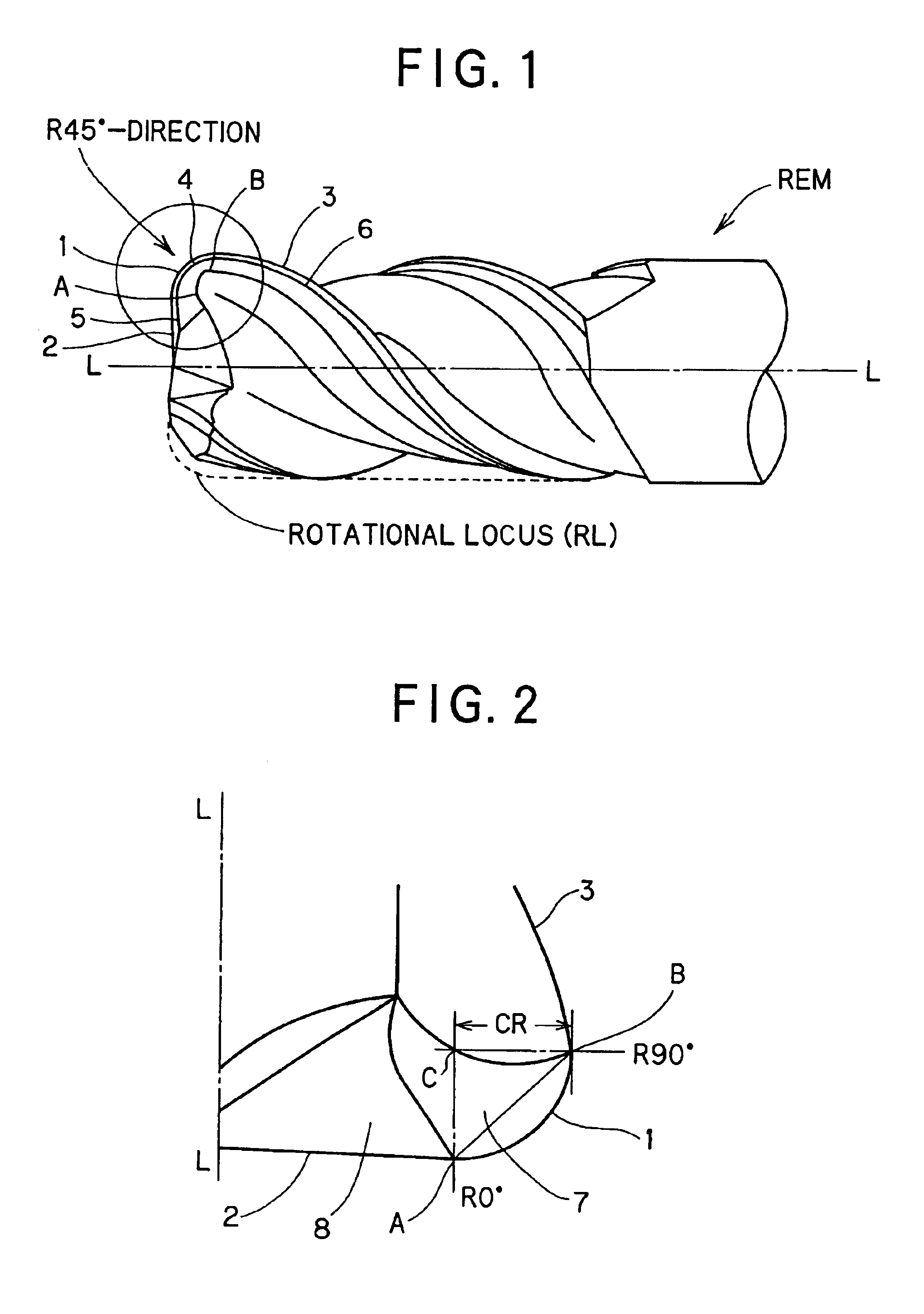Radius end mill having radius edge enhanced in resistance to chipping and fracture
a technology of radius end mill and discharging performance, which is applied in the field of improving the radius end mill, can solve the problems of increasing the contact frequency of the cutting edge with the workpiece, promoting wear, and unable to achieve a high cutting speed of the ball-nose end mill, so as to achieve enhanced resistance to the fracture of the r edge, the effect of high-feed cutting and enhanced discharging performan
- Summary
- Abstract
- Description
- Claims
- Application Information
AI Technical Summary
Benefits of technology
Problems solved by technology
Method used
Image
Examples
first embodiment
[First Embodiment]
Now, a first embodiment according to the present invention will be described with reference to FIG. 3.
FIG. 3 is an enlarged cross-sectional view of a corner portion of the radius end mill REM according to the first embodiment, which contains the line AB connecting the connecting points A and B, and corresponds to a plan view which is viewed from the side of the rake face 7 of the radius edge 1.
In this embodiment, the cross-section view of the corner portion of the radius end mill REM in FIG. 3 is achieved by cutting the corner portion of REM along a plane which passes through the two connecting points A and B (i.e., contains the line segment AB connecting the connecting points A and B) so as to intersect to the rake face 7 of the R edge 1. The cross-sectional view thus achieved will be hereinafter referred to as “R cross-sectional view”). According to this embodiment, the surface shape of the rake face 7 of the R edge 1 is designed so that the line shape 7′ of the ...
second embodiment
[Second Embodiment]
The radius end mill according to a second embodiment of the present invention is characterized in that a surface constituting the rake face 7 of the R edge 1 is designed to have a convex curved surface in the direction from the R90° site to the R0° site as shown in FIG. 4, and also the end gash face (the rake face of the bottom edge 2) 8 extending from the R0° site to the tool rotation axis (A—A) is substantially flat.
As described above, the chips generated at the R edge 1 are discharged along the rake face 7. According to this embodiment, in order to reduce the contact direction of the rake face 7 with the chips and lower the cutting force, the face constituting the rake face 7 of the R edge 1 is designed to have a convex curved surface in the direction from the R90° site to the R0° site. With this design of the rake face 7 of the R edge 1, the cutting stress against the rake face 7 can be prevented from concentrating to one direction and thus dispersed in all di...
example 2
A radius end mill in which the rake angle was set to a negative angle in both the R normal-line direction and the tool radial direction from the R90° site to the R0° site of the R edge 1 was manufactured in the same manner as the example 1, and the same cutting test as the example 1 was conducted on the radius end mill thus manufactured. As a result, in the example 2, the cutting stable was more stable, the tool wear width was further smaller and the machined surface was more excellent as compared with the example 1.
PUM
| Property | Measurement | Unit |
|---|---|---|
| angle | aaaaa | aaaaa |
| relief angle | aaaaa | aaaaa |
| width | aaaaa | aaaaa |
Abstract
Description
Claims
Application Information
 Login to View More
Login to View More - R&D
- Intellectual Property
- Life Sciences
- Materials
- Tech Scout
- Unparalleled Data Quality
- Higher Quality Content
- 60% Fewer Hallucinations
Browse by: Latest US Patents, China's latest patents, Technical Efficacy Thesaurus, Application Domain, Technology Topic, Popular Technical Reports.
© 2025 PatSnap. All rights reserved.Legal|Privacy policy|Modern Slavery Act Transparency Statement|Sitemap|About US| Contact US: help@patsnap.com



